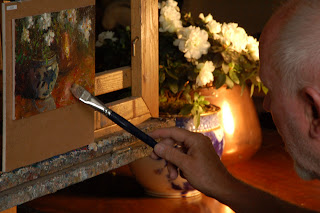Oil, 6 X 9 on Linen Panel
Demo: Flow Blue, Azaleas, and Copper
As we start, don’t assume that CW’s charismatic brushwork results from forgetting the fundamentals of drawing, value and color. His painting ability, knowledge, and mental effort are that much more in tune with the fundamentals of painting, which therefore allow him to work loose. A past reference to this would be the brushwork of Sargent, who could form an entire head with 20 brushstrokes, or even the modern day artists Carolyn Anderson, or Kevin Beilfuss who both use so little to show so much.
On a Claessens #13 portrait linen on Gatorboard (from Wind River Arts) CW marks out the frame reveal – which is necessary to keep in mind when painting small, making sure important information doesn’t get lost under the frame.
He draws with a small round brush and Yellow Ochre, paying most attention to his center of interest and marking other important landmarks. As in most paintings, this stage is critical for the success of the painting; a bad drawing means a bad painting.
Working from dark to light, CW masses in the major shapes paying attention mostly to values and overall temperature; relying on his drawing for accurate placement.
3. Soften block-in
After the block-in, CW “neutralizes” some of the brushwork so that at the end of the painting, the final brushstrokes will have more importance. This softening technique also helps recede the tertiary areas, which is very important to achieving a life-like representation of what you actually are seeing, portraying how your eyes focus. To soften slightly in the primary or secondary areas, he wipes with one-ply Kleenex. To soften the tertiary areas, he uses two-ply.
4. Laying in foundations
After softening, CW moves into laying the foundation for the flowers. This involves laying in the overall value and shape, and refining the exterior edges.
With the same method as the block-in, CW lays in the darks/shadowed sides of the flowers first. He uses a technique called “Marbleized Paint” which was discussed in Part One.
6. Adding details and final strokes
Once CW has painted the major shapes, he begins adding more detail with final, thick brushstrokes. In the photo above, you can see that he has laid in many of the leaves, the thick reflection on the copper pot (Which as you will notice could have taken dominance in the painting, but he kept the brighter reflection, values, and details for the foreground object.), and the details of the Flow Blue vase, it’s shadows and reflections.
7. Laying in the reflection
CW continues with the details and adds the reflection to the table, which although simplified, adds depth to the background pot.
8. Correcting the darker value on the bottom of the brass pot
9. Correcting the edge of the flow blue Jardinière and making
sure the value is right for the painting.
10. Mirror check
Above is a picture of CW with a large mirror behind him. He always uses the mirror as a check and balance to his work. Because the execution of a painting goes so quickly, your objectivity is usually limited. But with the mirror, he is able to see it in reverse and this helps immensely in seeing the painting with a fresh eye.
If you haven’t already, check out part one of this post. It has some great content about CW’s specific mixing and painting methods. When tied with the above demo, I think you get a very thorough grasp of how CW creates his works.
To learn more about CW Mundy’s techniques, you can purchase his videos:
Mastering the Dramatic Still Life with C.W. Mundy
Painting the Figure
Painting the Still Life
En Plein Air Collection (Not a demonstration video, but an account of his painting trips)
To keep current with CW’s news and events, visit his blog




































